Getting maths into the outdoors is one of the biggest concerns many practitioners have. It is probably the thing I am asked about the most where maths is concerned.
This post is by far the most comprehensive quantity of high-quality outdoor math activities for children aged 3 to 6 that you will be able to find all in one place.
Why do maths outside?
The benefits of maths outdoors are many, which include:
- You can do things on a bigger scale
- Maths can become really active and physical
- You can use a wider range of found objects
- You have the space for large games
- Some children prefer being outdoors and will access maths opportunities more freely than indoors
Outdoors offer both an opportunity to learn new things, as well as practice basic math concepts they already understand with bigger and more active resources.
Here we go – let’s get stuck into some of the best and tried and tested outdoor math activities that will get your children loving maths outside.
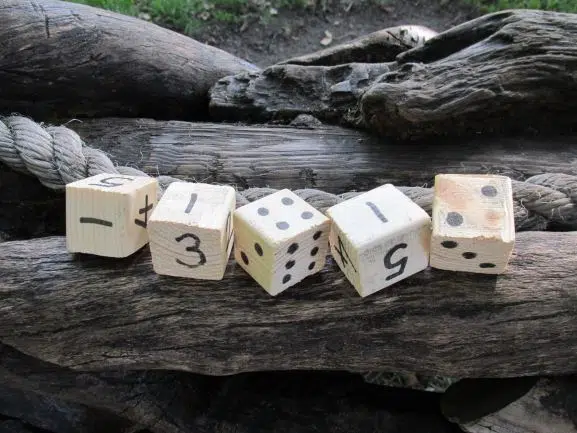
Number Stones
I have created quite an array of different types of number stones. These are actually great for use either inside or out. Lots of the math games I will demonstrate below can be played with these, although you can use many other things such as sticks, leaves, or conkers.
I just bought lots of white pebbles from a hardware shop and some acrylic paint.
If you’re looking to buy similar pebbles, something on Amazon like this will work.
For acrylic paint, some bog-standard primary colors like these will do the job.
I painted the stones with acrylic paint in different ways, and sometimes used a Sharpie pen if I needed to put an outline on them.
The number stones I have created include:
Sets of 1-10 Stones
These are alternately colored, yellow, white, yellow, white, to begin the idea of odd and even in a visual way. Great for ordering or using to label.
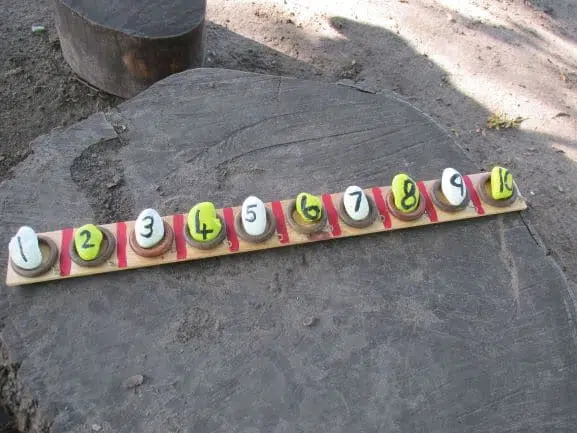
If you don’t want to create your own stones, you can also buy beautiful number stones, thus saving you time. Yellow Door painted number stones are a good choice (check out the latest price on Amazon here.)
Matching Numeral To Quantity Stones
Have some stones with numbers on, and some with quantities. It could be dots, or it could be something like insects.
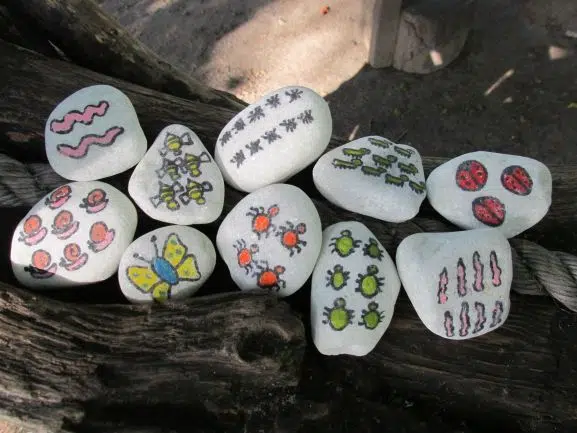
These are brilliant for one to one correspondence in particular. If you want to find out what one to one correspondence is, and the best ways to teach it, then check this out.
Animal Stones
I have some ladybird stones, some leopard ones, as well as some zebra and bee stones. Any animal that has a multi-colored pattern can be copied. These stones are great for games.
2s, 5s And 10s Stones
Great for higher-ability children in the early years, and for challenging younger kids who are starting to count in different ways.
These are perfect for ordering numbers in a range of ways.
Outdoor Models and Images
Mathematicians think in pictures.
Models and images seem to work really well outside because you can make them big, and they can be the focus of active games.
The benefits of using models and images include:
- They present maths as pictures
- They are visual
- They allow for problem-solving
- They allow for the manipulation of physical objects
- They can be used again and again, often in different ways
Chalkboard Paint
A lot of the resources that I have created are using black chalkboard paint. This is one of the ultimate resources in the early years. It is great for painting large surfaces for mark-making, such as fences, sheds, pallets, or old furniture.
I imagine any can of chalkboard paint would work, but I use American Crafts DIY Chalkboard Paint (check out the current price on Amazon). It does the job great.
I have painted several pieces of MDF from a hardware shop and then used these for games. However, you could just as easily chalk the games on the floor. I also once painted tree stumps with lots of games using acrylic paint. They lasted for at least a year, even out in the rain.
Addition Triangles
These are great for exploring number bonds. They represent the part-part-whole model used in Singapore Maths.
I have painted my addition triangles onto a piece of MDF. Using the animal stones (or another resource such as leaves and sticks), you can explore number bonds.
For example, start with five stones in the top circle. Split them up into different quantities, and put the stones in the two lower circles. For example, it could be 1+4, or 2+3.

Higher-ability children could try to record what they have found.
2 Sets For Addition
This math game is another good one when children are beginning to add. You can use painted stones, or just found objects from the area.
Place some objects in either circle and then simply count how many you have got altogether. This is an excellent way of adding two sets and finding the total.
Trellis Models And Images
One of the best things I ever tried was sawing up a big trellis that I found at a garden center. I am pretty sure I saw this on Pinterest but cannot remember where. I cut it up into many different models, such as:
- A ten frame
- A five frame
- A two-part addition frame
- A four-part frame
There are so many games that you can play using these. Children really love finding objects to experiment with in the frames.
Ten frames are a key resource to introduce to young children both inside and out. To find out more about what ten frames are and the many ways to use them, take a look at this.
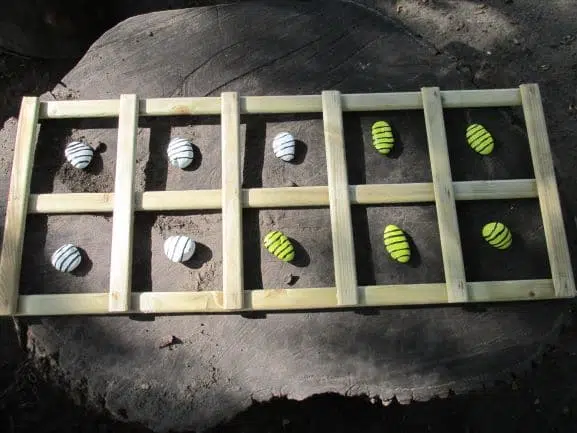
Board Games Outside
Board games are fantastic for a range of mathematical skills. They encourage:
- Counting for a purpose
- Subitizing
- Recognizing numbers
- Problem-solving
- Find more/less
Some examples of fantastic outdoor board games include:
Noughts And Crosses
This seems to be known more by the modern generation as tic tac toe.
It is a brilliant game for problem-solving and simple counting, as well as turn-taking. You can easily create simple boards on wood or logs, and use painted stones or objects such as pine cones and conkers.
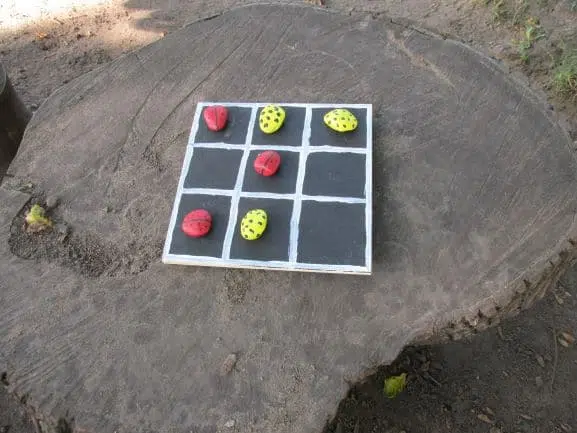
I have recently seen a board made out of rope.
It is good for simple counting, doing mental math and subitizing, as well as thinking ahead.
Connect Four
Another classic game from the old days.
If you play this game on the floor it is actually easier to get four in a row than if you play the standard plastic version.
Create a large grid board, and then use different objects for each player. It could be stones vs. conkers. Put one on at a time, and try to get four in a row. You can actually have more than 2 players if you want as well. Great for counting, subitizing numbers, tactics and problem solving.
Racetrack 1-6 Game
Have a dice with numerals on it and a board that is a simple grid, with numerals 1 to 6, and some other boxes. Pick which number you think will win, and put your colored stone at the top of the grid for that number. Then roll the dice multiple times. Every time you roll it, put a stone on the right numeral on the grid. The first number is the number that fills up its grid.
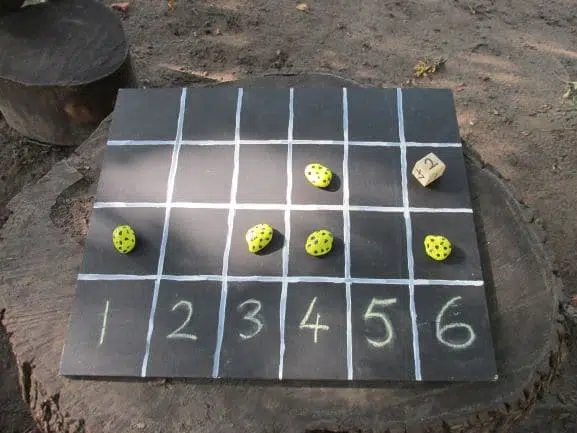
This is a fantastic activity for number recognition. If you want to find out my favorite 16 games to teach recognizing numerals, then take a look at this article.
Racetrack 1-12 Game
This is quite a bit harder, and has a lot of probability and calculating involved. But this game makes math problems and math equations more enjoyable to solve.
Have a racetrack that is a 12 x 4 grid. Have the numbers 1-12 written on the bottom of the grid.
You will need two dice, ideally a dots dice and a numeral dice.
To start with every player predicts which number they think will win. They use something such as a colored stone to signify this by putting the stone at the top of the grid in the number column.
Then you take turns to roll a dice. For example, you might get 3+4. Put a stone on the first box in the 7 column. Keep going, adding stones to the number columns. The ‘winner’ is the first number to come out 3 times and make it to the top of the grid.
This game is excellent for multiple things:
- Calculating
- Adding
- Counting on
- Predicting
- Probability – Numbers 6 and 7 are the two most likely to win. They have the most combinations of numbers possible. Number 1 can never win as you can never throw a 1 with two dice. Children may start to get a bit of an idea of this when they play.
- Thinking about ‘more’. I.e. how many more a number needs to win.
Number Line Race
This is a great way of exploring a number line.
Have a long number line either chalked on the floor (or painted on a piece of wood). Each child has one ‘counter’ such as a colored stone.
The idea is that everyone starts at the beginning of the line. The first child rolls a 1-6 dice. They move their stone along the line to that point (e.g. 5). Then the other children go. For the next go, you simply keep moving along the number line. The winner is the person that gets to the end first.
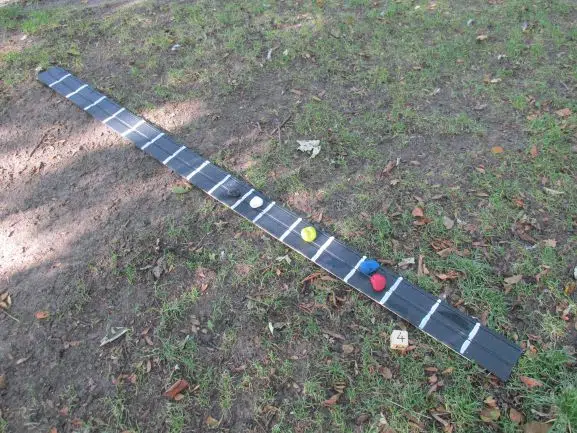
This is good for number recognition, and also problem solving (such as how far your opponent is ahead of you)
Blank Number Line Race
I also have a number line that has blank spaces on it. Children can add their own numbers to it.
They could be 1, 2, 3, etc., or they could mix it up. They could go backwards. Or they could start from a number that’s not 1. You could also do a game counting in tens.
Active Outdoor Math Games
Here are some physical outdoor games that can get children really engaged.
Stepping Stones
This is an excellent game of cooperation and teamwork.
I use rubber spots for this game with numbers on them. You can find similar spots to these at Amazon here.
You need one more spot than you have children, so if you have a team of six children you will need 7 spots (with numbers 1 to 7 on).
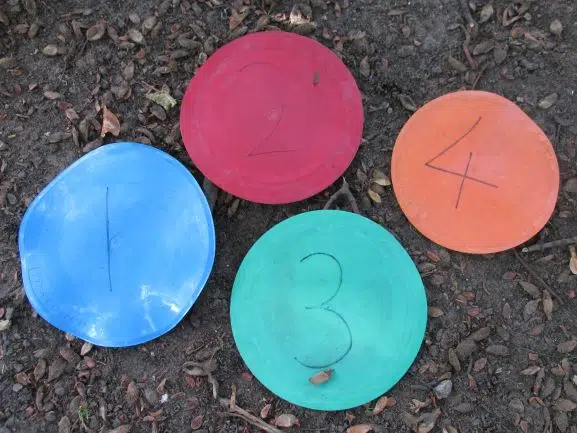
The children are in a line. The child at the front has all the spots (they have a hard job). The person at the back of the line actually has the hardest job, as they have to bend down and pick the spots up.
The idea is that the floor is now lava. You cannot stand on it. However, you can stand on the spots that are the stepping stones over the lava.
The child at the front finds number 1 and puts it on the floor. They stand on it. Then they put down number 2 in front of them, and step on that. Then number 3 etc. As there is a free stepping stone behind them, the others start to step onto the stones.
When number 7 is on the floor, the children should be standing on stones 2 to 7. Then it is the turn of the person at the back to pick up stone number 1 and pass it down the line.
They help each other to pass it down and the process starts again. The person at the back keeps on bending down and picking up the spare stepping stone.
I like to get them to say the number as they stand on it. This game is good for number recognition and ordering.
Using water spray-bottles
This is dead easy. Have water spray bottles and a dice. (A spray bottle looks a bit like this if you weren’t sure!)
Roll the dice and spray the bottle that number of times. It could be on the fence or on wallpaper. If you are brave you add a bit of paint to the water in the bottles.
Sticks Activities
There are so many learning opportunities can you perform with sticks including:
- Making 2D shapes.
- Ordering through size
- Making pictures – such as houses, vehicles, rockets, etc.
- Counting them
- Adding
- Making ten-frames, or number lines
Balloon Games
Balloons are great for physical development, cooperation, and turn taking. Some great outdoor maths games with balloons include:
- Have a small group of children in a circle (approximately 4 to 6 children). Write numbers on a balloon in pen. Maybe put about 6 numbers on the balloon. One child hits the balloon up into the air, then another hits it up and continues. When you hit the balloon, say the number that you hit.
- Have lots of balloons, each with one number on them. Start with one balloon, keep it up, and when you hit it say the number. Then add another balloon to the circle, then another. Keep saying the number as you hit each balloon.
- Have one balloon again (this time with no numbers written on it). The first person says ‘One’ as they hit the balloon. Then the next person says, ‘two’. Continue like this.
- The harder version is counting back from 10 to 0. The first person hits the balloon and says ‘ten’. Then the next person says ‘nine’ as they hit it, and so on.
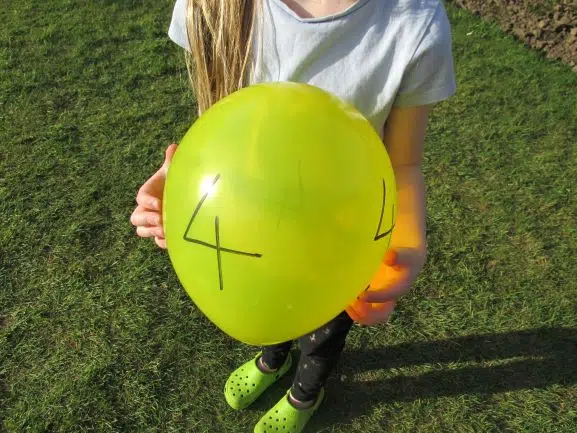
Maths Ball Games
All sorts of counting and number activities can really be brought to life with ball games. Here are some great examples:
Have Bibs With Numbers
This is one of the most fun outdoor math activities on this list!
Have shirts or bibs with numbers on that the children wear. The child-size version of these number sports vests would work well, as an example.
If you don’t have anything like this, you can write numbers on stickers and they stick them on their tops.
Stand in a circle.
The first child says a number that someone else is wearing and throws the ball to them. That person says ‘thank you’. Then that person chooses someone else, says their number and throws it to them.
This game can be done as a rolling game if they are struggling with catching.
Great for numeral recognition in a fun context.
Write Numbers On The Balls
Either put stickers with numbers on onto balls, or write directly onto them if you don’t mind having permanent number balls. We use large rubber balls that look a bit like this (check them out on Amazon).
Again this could be a rolling game or a throwing game, depending on the skills of the children.
Start with one ball, but you want to quickly extend it to at least two and hopefully more.
One child says someone’s name and throws a ball to them. That child catches it and says the number.
Then they say someone else’s name and throw it to them. Repeat.
If you have two or three balls going at once there is lots of communication and teamwork required.
Pass The Number Balls Around The Circle
Using the same balls that you created for the last game, play a simple numeral recognition game.
The children sit in a circle and pass the balls around. When they are holding a ball they say the number that is written on it, before passing the ball to the next person.
This game is good because even if you don’t recognize all the numbers, you can listen to the person next to you and copy what they have said. Hopefully, in this way, you are absorbing what the numbers are in some way.
For those who know the numbers already, it is great for speed and quick recognition practice.
Symmetry – Building Half A Giant Outside
This is a great provocation for using outdoors with natural loose parts – things like sticks, leaves, conkers, reels, and building blocks. Just whatever you can find in the outdoor space. To find out the many resources you can use for loose parts play, take a look at this list of at least 100 ideas.
There is a simple way to do it, and a trickier way.
The simple way is for the adult to draw the silhouette of a huge giant on the floor with chalk. Draw a central line down the center of the body, from the top of the head down to the feet.
Now children ‘build’ the giant. Whatever they place on one side – for example, 4 conkers for hair – they try to copy on the other side.
There are harder ways of trying this game out. One harder variation is just draw a central line on the floor with chalk and nothing else. Then, once again, they try to build the giant on one side, and copy it on the other. This will create a much more random creation, and really get them thinking
Washing Lines
There are so many things you can do with washing lines, and it really is so simple to set up. Pretty much all you need is a piece of string.
You can put the string:
- Between two fences
- Between two walls
- I know several teachers who have put wooden broomsticks into pots and then filled the pot with concrete so that the brooms stand up. These are great for creating a washing line between two brooms
If you put a washing line up outside, the big thing to be careful of is that children do not run into it by mistake. The big threat is things like neck injuries.
Some ways to combat this include:
- Having the string next to a wall or fence
- Have it above their head height, maybe with a platform for them to stand on to peg things on to it
- Have it in an area where running is not possible
Anyway, here are some fantastic outdoor washing line activities:
- Hanging up the giant’s clothes. The trick is to bring some large adult clothes in, and you will be amazed at how the children are convinced they are giant clothes. Hang them next to baby clothes, and talk about the differences in size
- Hanging up pairs of socks
- Finding objects outside, such as sticks and leaves and pegging them up. You can peg found objects up in patterns, or you can add or subtract from them. For example, you could have three red leaves and add two brown leaves. How many have you got altogether?
- Ordering numbers. Ideally use something natural, like pegs with numbers on them or wood slices with numbers on them.
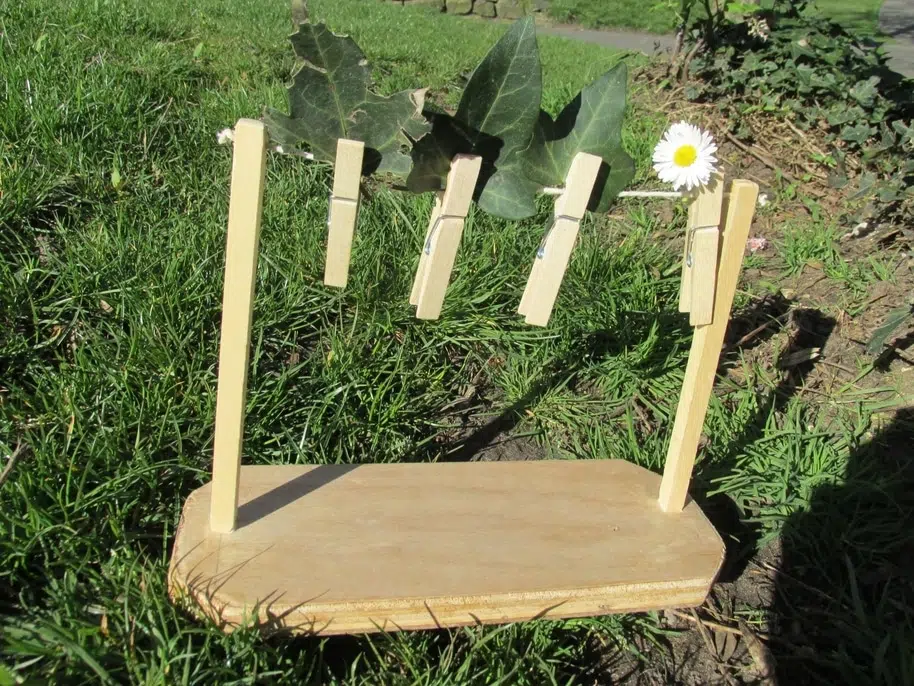
Parachute Games
Parachutes are another fantastic resource that can be used either adult-led outside or can be used independently if you model the games and how to use them to the children.
The parachute that I use looks like this:
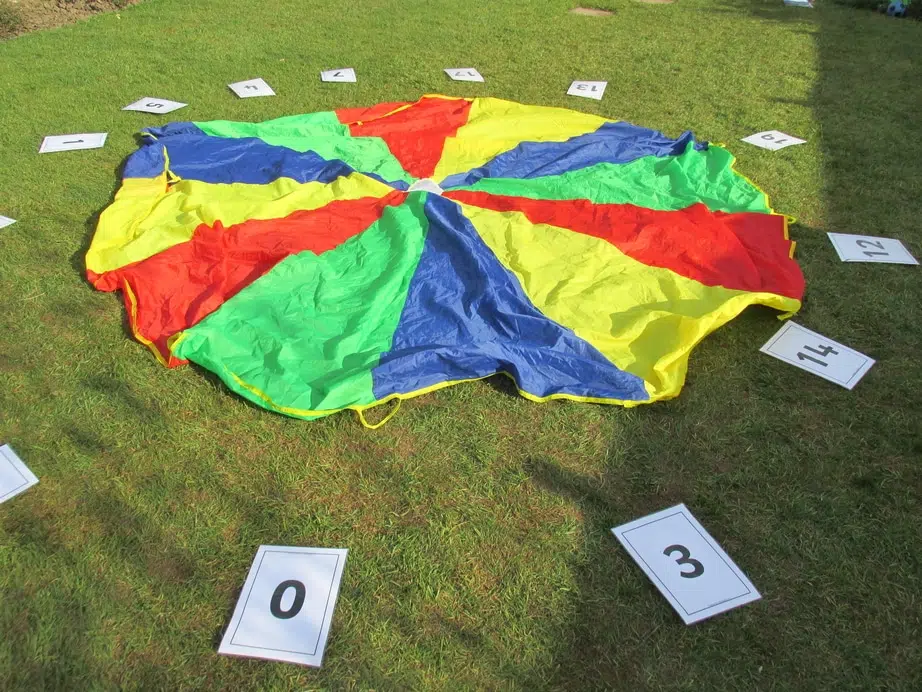
These are really resilient and can create years of fun and learning. (Check out the latest price of this parachute on Amazon).
Here are some excellent maths parachute games:
- Number dive. Have some numbers underneath the parachute. Have several children holding the parachute. Pick a child to go first, and say ‘1,2,3 – lift!’ Everyone lifts the parachute high into the air. Then shout a number. That child dives under the parachute, grabs the number, and brings it out to safety. Repeat for other children. If the children are doing it by themselves, then the child that has just gone picks the person to go next, and also what number they will get.
- Shape Dive! This is the same as number dive but with shapes.
- Singing counting songs. This works really well if you have some toys to go with it. For example, five monkey toys so you can sing 5 Cheeky Monkeys Jumping On The Bed. Great for singing the song, and taking off one monkey at a time. (Check out these gorgeous monkey finger puppets you could use for this activity here.)
- Bean bag bounce. This is an excellent number bonds game. Have ten bean-bags on the parachute. You have a few seconds where everyone tries to bounce the bean-bags off the parachute. Count back by going 5-4-3-2-1-0. When you get to zero, see now many bean bags are left on the parachute. You will always have a number bond. If there are two on the chute, then there will be three on the ground. If there are four on the chute, there will be six on the ground.
- Hit The Number! Have some rubber numbers (or something similar) and balance them on top of the parachute as everyone holds it together. Have a rubber ball for this game as well. The adult says a number, and everyone tries to roll the ball onto that number. This is a game of cooperation as well as number recognition. You can potentially make it harder by saying things like ‘one more than three’ (and trying to roll the ball onto number four).
Outdoor Games Top-Tips
- Make everything big!
- Make it active
- Use lots of models and images for games
- Use found objects like stones, sticks and leaves
- Use balls, and floor games, and things like balloons
Conclusion
Outdoor math games have loads of fantastic benefits.
It makes maths fun!
It consolidates prior learning in an active and concrete way.
It helps children to link maths learning to the real world.
It is also extremely cheap and quite simple to set up. Pretty much all of these outdoor math activities use resources that are easy to source, and cost next to nothing or are free.
So why not give outdoor math games a go today?
What Next?
If you are reading this and are based in the UK, then you may well be interested in my Practical Early Years Maths Training Courses that I run around the UK. Check them out to find a venue near you. All sessions are hands-on, practical, and based on numerous ideas to help you find success in teaching maths.
READ MORE
